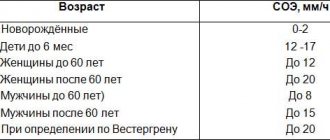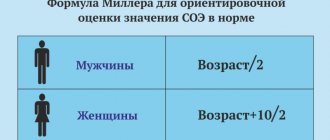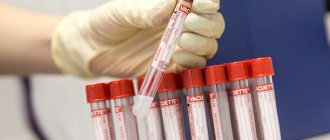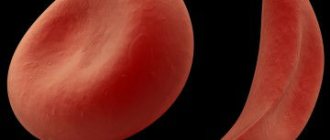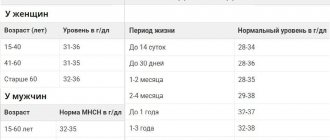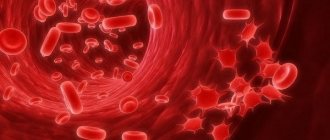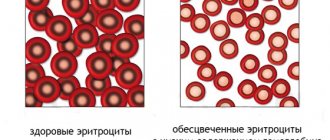In medical practice, one of the indicators of a person’s health status is the appointment of laboratory tests, the results of which determine the correct diagnosis. One of the basic ones is a blood test, which is mainly prescribed to patients whenever they visit a doctor with complaints about their health. The doctor deciphers the tests, however, often certain indicators raise a lot of questions in the patient, especially when trying to interpret them independently.
One of the fundamental criteria for analysis is the value of ROE, which is difficult for a person not associated with medical science to understand, as well as to determine the presence of difficult aspects based on this indicator. In this article we will tell you what the abbreviation ROE means, what is the root cause of fluctuations in this indicator, we will consider what the criterion for ROE in the blood should be, its norms for women, the stronger sex and children. Additionally, we will analyze in which cases non-compliance of the ROE with standards acts as an indicator of health difficulties and requires qualified assistance from specialists.
What does the abbreviation ROE stand for?
A superficial excursion into physiotherapeutic theory will help you understand what ROE is in a blood test. ROE is a complex abbreviated medical phrase interpreted as “erythrocyte sedimentation reaction.” Nowadays, analysis results often contain the abbreviation ESR, which indicates the erythrocyte sedimentation rate, however, in reality both indicators are identical.
When checking the settling criterion, no reaction occurs; the essence of establishing this indicator is to identify the ability of particles to sink in a glass flask under the natural pressure of gravity, which led to updating the abbreviation, replacing the word “reaction” with “speed”. The laboratory essence of measuring ROE is as follows: the rate at which red blood cells settle in a specific glass container is recorded in the number of millimeters, how much their level has decreased within one hour. Accordingly, the abbreviation ROE is outdated, however, it is still often used in blood test forms and medical documentation by “old-school” doctors.
How is ESR determined?
In order to find out this indicator, an anticoagulant (an element that prevents clotting) is injected into the blood for analysis and it is placed in a test tube placed in a vertical position for 60 minutes.
Plasma weighs less than red blood cells, which is why they settle at the bottom of the test tube under the influence of gravity. The blood will be divided into two parts: red blood cells will remain at the bottom, and plasma will remain at the top. After 1 hour, they look at the speed at which the red blood cells descend along the height of the emerging part of the plasma in millimeters. The number on the test tube scale located at the boundary between the two parts is called the sedimentation rate, measured in millimeters per hour.
In case of illness, the level of fibrinogen (this is one of the proteins of the acute stage of the inflammation process) and globulins (protective elements that appear in the blood to fight elements that cause inflammation - microbes, viruses) increases in the blood, which can lead to clumping and precipitation erythrocytes and an increase in the indicator.
As a rule, the ESR begins to increase a day or two after the inflammation begins, and becomes much higher somewhere in the second week of the disease; sometimes the peak occurs during recovery from the disease. This is due to the fact that the body needs time to produce antibodies in the required quantity. Measuring an indicator several times will provide more information than measuring a given indicator just once.
Various methods are used to identify the level of an indicator. The Panchenkov method remains the most common in Russia . At the global level, the most common measurement method is Westergren analysis .
These methods can be distinguished from each other by different test tubes and scoring scales. The scope of the norm for these methods is the same, but the second method is more sensitive to an increase in the indicator, and in the range of values above the norm, the results taken by the second method are greater than the results that were determined by the Panchenkov method.
Diseases serving as an indicator for the study
Laboratory diagnosis of ROE indicators can be prescribed by the attending doctor in the presence or suspicion of the presence of such painful conditions:
- inflammatory or infectious processes;
- the presence of pathologies that are characterized by complications in the form of necrosis of tissue joints; medicine includes heart attacks, malignant tumors, purulent formations, tuberculosis, and intestinal diseases;
- connective tissue diseases such as rheumatism, arthritis, lupus, dermatitis;
- diseases that are based on metabolic and hormonal imbalances; the main diseases in this category that affect ROE are diabetes mellitus, increased or decreased production of hormones;
- anemic disease, significant blood loss and hemolysis are the primary sources of a decrease in the number of erythrocytes, and, accordingly, the cause of a decrease in ROE;
- nephrotic syndrome, which provokes the progression of liver disease;
- female changes in the body due to the menstrual cycle, menopausal changes, pregnancy or after childbirth;
- the period after surgery or surgical intervention are direct indicators for monitoring ROE values;
- measurement of ROE is indicated for increases in cholesterol;
- prolonged use of medications;
- intoxication of the body with life-threatening chemicals.
It is worth noting that for different diseases, the pattern of changes in ESR may vary depending on the stage of the disease, as well as the characteristics of its course. Only a specialist can competently interpret the picture of ESR variations, in accordance with additional examinations, patient complaints, and the clinical picture of the disease.
Characteristic
Red blood cells are blood cells whose main function is to provide the tissue structure with oxygen. The secondary function of red cells is maintaining the acid-base balance and participating in the lipid process.
The term ROE
To determine ESR, a special anticoagulant (a substance that prevents the clotting process) is used. Afterwards, it is placed in a medical test tube (only vertically), for no more than sixty minutes. This manipulation is carried out so that erythrocyte sedimentation occurs.
- ESR in rheumatoid arthritis - Orthopedist.info
Reference! Sedimentation occurs due to the fact that plasma has less mass than red blood cells. As a result, there is a division into a pair of layers: red blood cells will be below, and plasma will be at the top.
Blood cells
After the stratification process, evaluation is carried out. The assessment takes into account the height of the red blood cell layer (measured in mm/h). Depending on the state of the red cells, the thickness of the layer will be determined. If a person has an inflammatory process, then the level of fibrinogen (a certain protein that is produced during inflammation) and, accordingly, globulins (antibodies that perform a protective function when an inflammatory process occurs). Under the influence of the pathological process, red blood cells stick together and, as a result, the sediment has a higher value than normal. A blood test shows an increased ESR value.
From the first days of activation of the pathology, there is a gradual increase in ESR, which reaches its maximum on the fourteenth day of the disease.
Note! A high rate is diagnosed not only in the last days of the disease, but also during the recovery stage. Therefore, it would be more rational to monitor the dynamics of changes in ESR.
Consequences of changes in ESR
Factors determining the erythrocyte sedimentation rate
The ROE criterion, with the exception of blood clotting characteristics, is influenced by two fundamental factors:
- number and structure of erythrocyte type cells;
- quantitative and qualitative composition of plasma.
In a healthy state, red blood cells have the characteristic of antimagnetism, due to the negative charge on their surface. Normally, red blood cells circulate along the highways under the influence of a repulsive force. Activation of immune mechanisms directly affects the increase in quantitative indicators in the composition of the plasma of immunoglobulins, which, in turn, provokes a decrease in its density and ductility. The consequence of this process is a change in the charge on the surface sphere of the erythrocyte, which results in the formation of enlarged and massive erythrocyte compounds, which sink under the influence of gravity in an accelerated manner.
The opposite reaction is characterized by a precedent when plasma becomes more concentrated than it should be according to natural standards. In such a situation, red blood cells, compared to plasma, lose weight and, accordingly, remain in a “suspended” state for a longer period, which is characterized by a decrease in ROE.
Reasons for the increase
Often, a high blood ROE criterion is an indicator of the presence of pathological conditions. The reasons for the critical increase in ROE in the blood may have the following etiology:
- infectious, autoimmune or oncological diseases;
- aggravated inflammatory processes with varied localization and typology;
- serious blood loss, hemorrhage or anemic conditions;
- uncontrolled intake of medicinal substances, which gave rise to transformations in the composition of the blood at the molecular level.
It is not always possible to determine what causes an increase in ROE in test results using one blood test; additional examinations of the body may be necessary to diagnose the original source of the precedent. Often, ROE criteria increase slightly against the background of standard physiological changes in the body and are not a reason for panic; they act as a standard reaction and are considered normal values. The physiological root causes of an increase in ESR may include changes in people of retirement age or in children against the background of age-related changes, during periods of hormonal changes in the fairer sex as a result of taking hormonal substances, poor nutrition or incorrect testing.
Reasons for the downgrade
ROE slowdowns are a rarer phenomenon in practical medicine. Often, such precedents in non-critical variations are not a cause for concern; they may indicate normal overwork of a person, minor intoxication of the body or dehydration.
Critical decreases in ROE are often an indicator of the progression of jaundice, hepatitis of various types, sickle cell anemia, the presence of a tumor, which requires additional examination of the patient.
Diseases in which there is an increased ESR in the blood
If a patient has an elevated ESR in the blood, what this means is determined by the doctor during the diagnostic process. After all, this indicator is very important for diagnosis if the development of a certain disease is suspected. In the diagnostic process, a qualified doctor takes into account not only the fact that the patient has an increased value, but also determines what the presence of other symptoms indicates. But still this indicator is very important in many cases.
ESR: increased in diseases
An increased ESR in the blood of a child and an adult is observed if a bacterial infection - during the acute phase of a bacterial infection.
In this case, it does not matter where exactly the infections are localized: the picture of the peripheral blood will still reflect the inflammatory reaction.
viral infectious diseases occur . What specifically causes this indicator to increase is determined by the doctor during a comprehensive examination.
Thus, we are talking about the development of a certain pathological process if the ESR is higher than normal. What this means depends on the value of the indicator. Very high values – more than 100 mm/h – occur with the development of infectious diseases:
- for sinusitis , bronchitis , pneumonia , ARVI , colds , tuberculosis , influenza , etc.;
- for cystitis , pyelonephritis and other urinary tract infections ;
- for fungal infections , viral hepatitis ;
- in oncology (high rates can be observed for a long time).
During the development of an infectious disease, this value does not increase quickly; an increase is observed after 1-2 days. If the patient has recovered, the ESR will be slightly elevated for several more weeks or months. The reasons for a high ESR with normal leukocytes may indicate that the person has recently suffered a viral disease: that is, the leukocyte count has already returned to normal, but the red cell sedimentation rate has not yet.
The reasons for increased ESR in the blood in women may be associated with pregnancy, therefore, in the diagnostic process, the doctor must take into account these reasons for the increase in ESR in the blood in women.
An increase in ESR is a typical symptom in the following diseases:
- diseases of the biliary tract and liver;
- inflammatory diseases of a purulent and septic nature ( reactive arthritis , etc.);
- blood diseases ( sickle anemia , hemoglobinopathies , anisocytosis );
- ailments in which tissue destruction and necrosis ( stroke , heart attack , tuberculosis , malignant neoplasms);
- pathologies of the endocrine glands and metabolic disorders ( obesity , diabetes , cystic fibrosis , etc.);
- malignant degeneration of the bone marrow, in which red blood cells enter the blood that are not ready to perform direct functions ( myeloma , leukemia , lymphoma );
- autoimmune diseases ( scleroderma , lupus erythematosus , rheumatism , etc.);
- acute conditions in which the blood becomes more viscous ( diarrhea , bleeding , vomiting , postoperative conditions , etc.).
Methodology for diagnosing the ROE coefficient
To specify the ROE coefficient in laboratory practice, two methodologies can be used: the Panchenkov method or the Westergren version. Both methods are not nonspecific; they involve taking capillary blood in the first case and taking venous blood when using the second method. The methodologies differ from each other exclusively in the test tubes used to measure the parameter, which vary in volume and scale.
In the first case, a test tube is used, which is ten centimeters in length. To obtain the final data, blood is mixed with an anticoagulant in a certain proportion, left for an hour, after which the measure of erythrocyte sedimentation is assessed.
Westergren's methodology involves settling the substance in a test tube, the length of which is twenty centimeters, while the blood for settling is dissolved with sodium citrate. As in the previous case, the results of the study are assessed after an hour.
Regardless of which method is used to determine erythrocyte sedimentation, the result will be identical if the procedure is performed correctly.
Important Notes
Material for research Capillary blood.
Children under 7 years of age: venous blood/capillary blood (for special indications). Children over 7 years of age and adults: venous blood. Capillary blood collection for research is carried out only for children under 7 years of age (for special indications)! According to GOST R 53079.4-2008, indications for taking capillary blood are possible: in newborns, in patients with very small or hard-to-reach veins, with large-area burns, and in severely obese patients.
Features of preparation for testing
The value of ROE in a blood test can vary depending on many internal and external factors. In order to obtain the correct designation for the rate of red blood cell descent, it is important for the patient to adhere to certain rules before taking the test.
When studying using the Panchenkov method, doctors recommend that the patient take the test on an empty stomach, in the first half of the day, and the day before the study, rationalize his diet, remove fatty, spicy and salty foods from the menu.
When planning a study using Westergren’s methodology, it is necessary to adhere to similar recommendations, while the period of abstinence from irrational food should be increased to two days, and food consumption should be excluded twelve hours before the planned procedure.
It is worth considering that drinking tea, coffee or other drinks, except water, in the morning can affect test results. In addition, experts recommend not smoking for an hour before the procedure, since nicotine may also affect the results of the study.
Physiological normative standards and pathological variations of the ESR criterion
Let's consider what the ROE coefficient should be in a healthy person, depending on his gender and age. The standards for the erythrocyte sedimentation reaction have a large-scale amplitude of fluctuations and differ in accordance with physiological characteristics, the nature of human nutrition, exogenous and endogenous circumstances affecting the functioning of the body.
The differentiation of ROE indicators looks like this:
- For men and teenage boys, the norm for ROE in the blood is from one to ten millimeters per hour.
- The cell sedimentation rate for women and teenage girls is considered standard if its criteria range from two to fifteen units.
- For people of retirement age, the ROE rate ranges from fifteen to twenty millimeters per hour.
- The norm for children under ten years of age is determined regardless of gender, differentiated by age criterion. For newborns, ROE variations from three to four are standard, while the norm for infants and children under ten years of age is from three to ten and from four to twelve units, respectively.
If the ESR results do not meet the standard, in medicine it is customary to talk about a slowdown or acceleration of the erythrocyte sedimentation reaction, which can act as an identifier of abnormal phenomena in the body of the person being studied. The phenomenon of non-compliance with the standard criterion for sedimentation of erythrocyte compounds is characterized by a change in their properties at the molecular level, which makes them temporarily defective. Deviations of ESR from the standard should be a reason to visit a doctor in order to identify the cause of this precedent.
MCH norm indicators
The figure varies depending on gender and age. For newborns (up to 1 month), ESR ranges from 1 to 2 mm/h. These limits are explained by reduced protein concentration. From 1 month to six months it ranges from 12 to 17 mm/h. This sharp increase in the norm is explained by age-related processes that occur in the growing body. Then the data is stabilized - for a child under 10 years of age, normal limits are considered to be numbers from 1 to 10 mm/h.
Since blood viscosity has several gender differences, the ESR rate will be different for men and women. For representatives of the fair sex from 10 to 50 years old, the acceptable limits are 0-20 mm/h, and from 50 years old - from 0 to 30 mm/h. The number may change during pregnancy, which is normal, but requires monitoring by your attending physician. In men from 10 to 50 years old, this figure should be from 0 to 15 mm/h, and over 50 years old - from 0 to 20 mm/h.
| Age, years | ESR norm |
| Baby up to 1 month | 1-2 mm/h |
| Child 1 month – 6 months | 12-17 mm/h |
| Child under 10 years old | 1-10 mm/h |
| Woman 10-50 | 0-20 mm/h |
| Woman over 50 | 0-30 mm/h |
| Male 10-50 | 0-15 mm/h |
| Man over 50 | 0-20 mm/h |
The final result is influenced by many factors: improper preparation, anxiety, taking medications and much more. In addition, the value may even depend on the time of day. As a rule, the maximum is determined around noon.
Fictitious increase in indicators
An increase in the ROE coefficient beyond the limits based on age and gender does not always indicate the presence of pathology in the patient’s body. There are cases when elevated numbers are false indicators of illness. The following factors can provoke this result:
- the patient has varying degrees of obesity, unhealthy diet;
- elevated cholesterol levels, which can cause an increase in ESR;
- the patient is taking vitamin complexes or drugs of a medicinal group with a high content of vitamin A, as well as using oral contraceptives;
- recent vaccination against hepatitis;
- features of the female body;
- the presence of regular depressive and stressful overstrains.
The task of the attending doctor in such a situation is to correctly interpret the test results, and if there are doubts about the reliability of the data, send the person for re-analysis and prescribe auxiliary studies.
Prevention
To prevent deviation of a nonspecific indicator means to prevent the development of the disease. To do this you will need:
- lead a healthy lifestyle;
- eat properly and nutritiously;
- devote time to sports;
- strengthen the immune system;
- regularly take vitamins (preventive courses of multivitamin preparations);
- undergo annual preventive examinations;
- promptly sanitize foci of chronic infection;
- promptly and completely treat all emerging diseases.
Specifics of ROE normalization
The most common cases in medical practice that cause concern are cases where blood ROE exceeds regulatory standards. With such results, patients naturally have a question about how to lower ESR, however, there is no clear answer to it, since the specifics of eliminating this problem depend on a variety of factors.
The specifics of reducing ROE include:
- diagnosing the cause of the precedent;
- therapeutic measures aimed at eliminating the basal disease;
- systematic monitoring of indicators until they are restored to normal standards.
People whose ESR is slightly higher than normal and does not have pathological support may be recommended to take preventive measures, which include the following:
- Rationalization of your diet by avoiding foods that are harmful to the body, enriching your diet with healthy foods, balancing your daily menu.
- Control of the daily routine with the correct alternation of work and rest, supplementing the regimen with daily walks in the fresh air.
- Refusal of addictions, the main ones of which are smoking and alcohol abuse.
- Maintaining a healthy lifestyle.
If the root cause of the increase in ESR is a consequence of pathological reactions in the body, the erythrocyte sedimentation rate can be reduced only after identifying and eliminating the key ailment. The methodology for reducing indicators depends on the severity of the underlying disease and may include both drug treatment with the prescription of antibacterial, anti-inflammatory and antihistamine drugs, and surgical intervention if necessary.
Traditional medicine also plays an important role in stabilizing ROE indicators. Let's look at how to reduce erythrocyte sedimentation in the blood using folk remedies effectively and without compromising your overall health. For this purpose, traditional medicine recommends the use of herbal decoctions and teas that have immunostrengthening and anti-inflammatory effects. Chamomile, calendula, linden, and sea buckthorn are considered the most effective in this area. Drinking raspberry tea with the addition of honey or lemon will have a positive effect on the body.
The following folk recipe perfectly helps improve immunity and reduces the growth of ESR: a mixture of chopped garlic (about one hundred grams) and lemon juice squeezed from five lemons, use one spoon before bed, first dissolving in water.
Not the least place in restoring the composition of the blood and its physiological characteristics is occupied by ordinary red beets. Beets can be added to your daily diet in raw or boiled form, or you can drink freshly squeezed juice from it.
Treatment of the problem with folk remedies is acceptable in the absence of serious diseases or in complex combination with drug therapy.
Let's sum it up
Many people are skeptical about the blood test that is prescribed to almost every patient who comes to a medical facility. In fact, the results of a blood test, even a typical one, are very informative if interpreted by a qualified specialist.
Each indicator as a result of the analysis, including ROE or ESR, which is the same parameter, can help determine the presence of a developing or progressive pathology. A deviation of the ROE coefficient from the norm can be either a natural reaction to various external or internal provocateurs, or indicate a serious illness. In case of any deviations from the standards, it is important to consult a doctor in a timely manner in order to promptly and correctly determine the cause and competently eliminate the problem.
What is ESR?
ESR is the erythrocyte sedimentation rate; the erythrocyte sedimentation reaction (ESR) analysis is also used.
The erythrocyte sedimentation rate is one of the indicators by which you can find out about the course of inflammation, diverse in origin.
Erythrocyte sedimentation rate (ESR) is a blood test that measures how quickly red blood cells (red blood cells) settle to the bottom of a glass tube containing a blood sample. The test actually measures the rate of fall (sedimentation) of red blood cells in a blood sample that has been placed in a tall, thin vertical tube.
